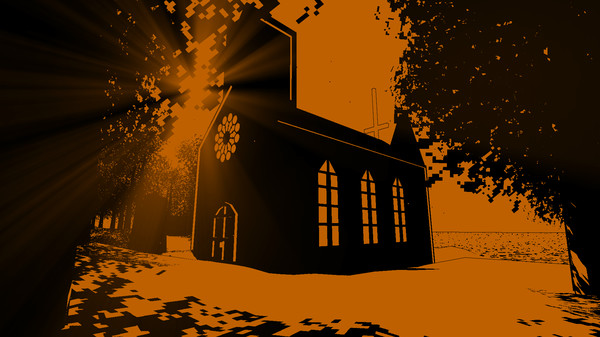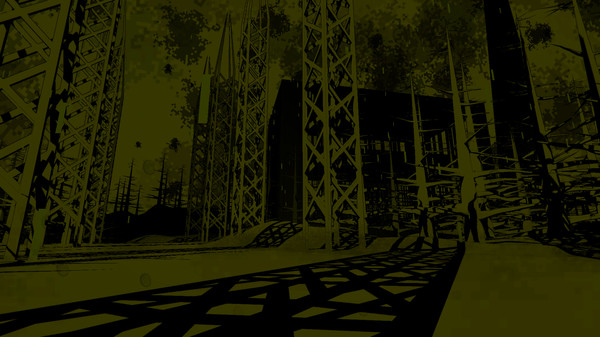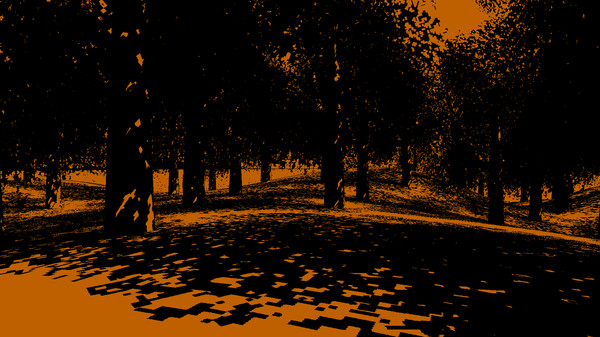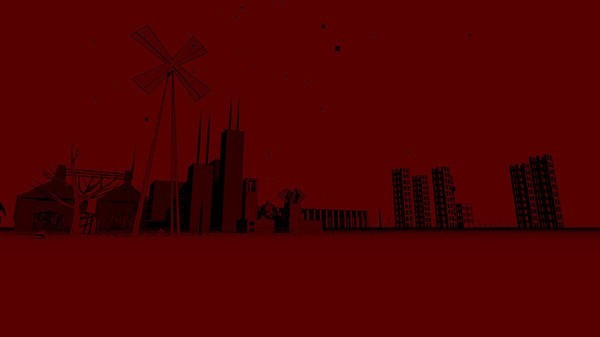We live in an age where games like Gone Home and Dear Esther find success, but some indie devs aim to add a bit more to the experience. David Szymanski is one such developer, creating a wide variety of indie games that have earned him a cult following. I sat down with David to talk about his most recent game, The Music Machine.
For those who don’t know, what is The Music Machine?
David Szymanski (DS): Well, it’s a narrative-focused horror game where you play an angry ghost who’s possessing a teenage girl and looking for a gruesome way to kill her. You start on an island where several disfigured bodies were recently found, and gradually uncover the bizarre secret that it hides. It’s a very narrative-focused experience, and most of the interaction involves examining things in the environment, which give you bits of exposition or conversation between the two characters.
Later on there are a few simple puzzles and other challenges as well. A lot of people refer to it as a “walking simulator,” but I just think of it as an adventure game where the focus of the interaction is one telling an interesting story rather than providing challenging puzzles. I took a lot of inspiration from the way The Vanishing of Ethan Carter combined exploration, puzzle solving, minor gameplay, and narrative. And I think it’s much more akin to that than to something like Dear Esther.
What inspired you to create a game where not only are the protagonist and antagonist in the same body, but also has you basically playing as the villain, seeing as how Quintin possesses her body?
DS: I like the idea of forcing the player to be the “bad guy.” Because I really like exploring the motivations and psyche of traditionally evil characters, and kind of challenging the player to face the fact that evil people are people as well, and often can’t be dismissed as unknowable boogeymen. Even the atrocities of Hitler make sense if you look at things from his worldview, and that’s a scary thing. That was basically the entire point of [my other game] Fingerbones. To show how even the most morally depraved of actions could be justified with logical thought, if you lack a conscience.
Getting back to The Music Machine, though… I don’t really consider Quintin to be evil. He’s a very flawed, broken person, to be sure… but ultimately, so is Haley. And that was the dynamic the player is supposed to get from them. They are just two lonely, screwed up people, who found each other and both harm/help each other as a result. Kind of like all of us really.

In answer to your other question, about the idea of having two characters in one body… it was just a random idea I had. I thought it would be kind of interesting to take the idea of “player controlling an avatar” and make it a little more meta.
I came up with the idea before I started working on The Music Machine, and originally I had wanted to do a lot more with it. Have your character trust or distrust you depending on your actions, maybe do something with the idea of harming them to help them, stuff like that. Once I started putting the story of The Music Machine together, though, a lot of that stuff didn’t fit with the characters.
Why did you go for a heavy emphasis on shadow, minimal detail, and limited sound? The game is sometimes notably silent, save for one or two solitary sound effects.
DS: Well, part of the reason is that I really am a minimalist at heart. I’ve always seen an inherent aesthetic appeal in using the least amount of material possible to achieve a goal. To me, simplicity is beautiful. It also lends itself to the sort of atmosphere I like exploring. Lonely, creepy, barren… that sort of thing.
In terms of sound, there are times where simplicity and silence were intentional choices. In The Void and The Chapel, for instance. Other times I probably could have done more. The Island, for example, might have benefited from more environmental sound work. That’s something I’m focusing on in my next game, which is much smaller in scale and will allow me to put more detail into everything.
Graphically, the game looks like it does basically because I’m not a very good artist, but I’m good at figuring out ways to hide it. In this case, I could have made the game smaller in scale and focused on making it look realistic, but that’s not very fun to me. And I’m simply not good enough to compete with other indies in that regard. So I just did what I usually do. If you can’t beat em, invent your own contest.

While I’m not very good at modeling or texturing, I am good at coming up with interesting art styles. So I spent a lot of time experimenting, and trying to find a visual style that expressed the atmosphere I wanted, was versatile enough to look good in more than one area, and focused on my strengths (lighting and shadows) rather than my weaknesses (modeling and textures).
Eventually after much tweaking, I ended up with The Music Machine‘s art style. It “felt” how I wanted, it was unique and interesting — well, more unique before White Night came out. And it was something I could make look good.
This is one of the reasons I basically do everything myself. There are some areas I’m good at, some areas I’m bad at, but ultimately it’s the sum total of the good and the bad that make my games uniquely my own.
If I had simply paid someone to do the modeling and texturing for me, The Music Machine would have ended up looking pretty much like every other Unity horror game. Art is defined as much by its weaknesses as its strengths. And working with and around those weaknesses just forces you to be that much more creative.
In the game’s pause menu, you specifically ask players to take their time and explore. Unlike a lot of horror games, you put a heavier, almost Ridley Scott-like emphasis on slow-burn tension and atmosphere. What drove you to this method of unsettling the player?
DS: Personal taste, really. I just find the buildup to be more interesting than the payoff, much of the time. Don’t get me wrong, payoff is important too. But most horror games just focus on “the scares.” In fact, a lot of players do also. “This isn’t a horror game! Where are the scares??” Not realizing that horror is much more than just that jolt, that adrenaline rush. I actually don’t enjoy that at all. It’s not thrilling for me, it’s just unpleasant.
The scariest game I’ve ever played is probably Amnesia: The Dark Descent, but I wouldn’t say I liked it. The whole thing was just a mechanism to trick me into a fight or flight response, and nothing more. I mean, visceral scares and terror certainly have their place, but to me they are more satisfying and enjoyable if that place is in some sort of story context.
Creepiness, atmosphere, unsettling themes… those are the things that intrigue me about horror. And it was Agustin Cordes’ game Scratches that showed me how that sort of literary approach to horror could be done in an interactive setting. And how even the most traditionally mundane of things–a scratching noise, a dark basement–could be absolutely terrifying given the proper context, and the proper time to develop.
Remember how I mentioned that I’m a minimalist at heart? Well, given the option between scaring people with a pile of mutilated bodies and a screeching monstrosity, and scaring them with one well-timed creepy noise, I’m going to go for the creepy noise.
You allude to a lot of the back story between Quintin and Haley vaguely. Did you intentionally leave some elements up for interpretation or is there a specific story you had in mind that led them to the current situation?
DS: Some parts are up for interpretation, but I did have a specific story in mind. Basically… [SPOILERS FOLLOW]
———————————SPOILERS——————————————-
Haley was a very lonely girl who was mostly ignored by her father, and ended up meeting and spending a lot of time with Quintin, a similarly lonely 34 year old man. The two did things such as watching movies together and target shooting, and they were close enough that Quintin paid to send her to camp. Eventually, Haley started to have romantic feelings for Quintin, which Quintin did not return. Angry and hurt, Haley lashed out by lying to her father about being molested by Quintin. An accusation she didn’t fully understand the gravity of. Her father responded by shooting Quintin to death. And the rest, as they say, is history.I read an article where someone was horrified by this part of the game, because there are so many molestation victims that (apparently) never seek help, fearing they won’t be believed. The Music Machine isn’t supposed to speak to that at all. It’s not a game about social issues, it’s about characters, and Quintin and Haley’s behaviors were very much directed by how I’d written them as people.
As I said before, it’s about two very screwed up people. One of which resorts to rape accusations when they feel slighted, the other of which is so vindictive that he will seriously consider turning a teenaged girl over to be tortured to death. And yet, ultimately, it’s also about a girl who is able to love unconditionally, and a man who can still do the right thing when the chips are down. [At] the end we get the impression that maybe their relationship might be on the mend.
——————————SPOILERS END HERE——————————–

What drives you to make your game projects? They differ a lot from the mainstream crowd, but you’ve gained a following.
DS: Making games in general? That’s kind of a compulsion. Making these specific sort of games? Basically I saw a niche that I thought needed filled, and I decided to fill it. And once I started working on these sort of games, I realized they are kind of what I’ve wanted to make all along. Stuff that focuses on exploring, stillness, creepiness, somberness, and narrative.
I guess if you had to label what I do, you might say I make “walking simulators.” But I’ve never thought of myself as a “walking simulator” developer. I just tell the stories I want to tell, in the worlds I want to explore, and pick and choose interaction mechanics based on what I feel will work in those stories and worlds.
Who knows, in the near future you might see something super gameplay-focused from me. Heck, I prototyped a zany little old school FPS after releasing The Music Machine that I might do something with. Ultimately, I’m not married to a particular genre, I just look at what doesn’t exist that I think should exist, and make that.
The way I see it, by the time a trend becomes popular enough for you to notice it and decide to jump on it, you’re already too late. It’s already starting to lose momentum. If you just do your own thing, then maybe you’ll be the one that starts the next big trend. At the very least, you won’t have to compete with bigger developers that have a lot more resources than you do.
At the end of all my interviews, I like to let my interviewees ask me and/or my audience a question. So if there’s anything you’d like to ask, please be sure to shoot it my way!
DS: What do you value more in games? Polish and entertainment value, or human imperfection and artistic value?
As for myself… I’m kind of in the middle ground. I like games to be entertaining, not necessarily always needing to be fun, but entertaining nonetheless. Still, at the end of the day, I’ll value a game more for presenting a new idea in an interesting way than for just being polished. You don’t get Sunset Overdrive and Thomas Was Alone by treating things like Assassin’s Creed.
What about you? Do you prefer polished experiences or more divergent, artistic games? Let us know in the comments below!
You can find more of David’s work on Steam and GameJolt. The Music Machine is available on Steam.
[Image Source: Steam]







Published: Jun 25, 2015 12:43 pm